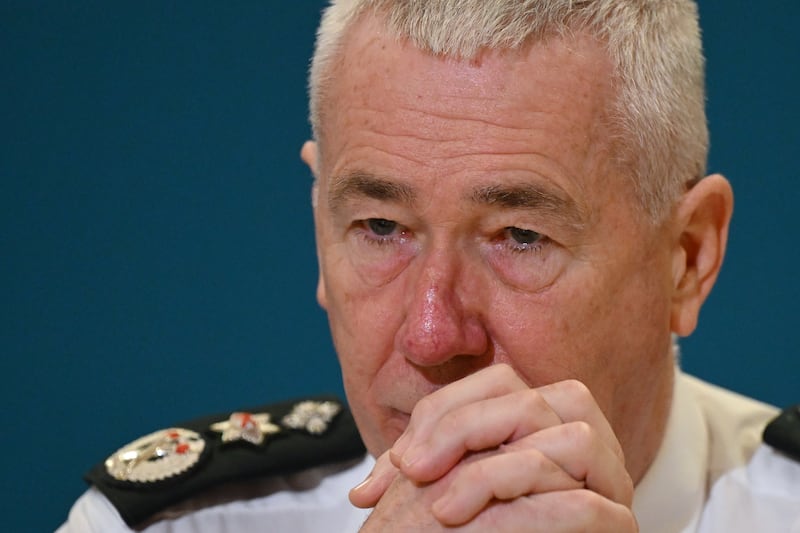June 2017 was a crunch month for Derek Quinlan in his efforts to free himself from Nama, the State agency set up after the 2008 global banking crash to save the domestic banking system by taking over bad property debts. He had a potential deal to put to the State agency.
The month hadn’t begun too auspiciously for his relations with Nama. Quinlan, a major boomtime property investor who was the biggest Nama debtor, clearly hadn’t flagged the full details of his role in advising a consortium on a potential €1.3 billion bid to buy the Finance Tower in Brussels.
On June 2nd, 2017, his role in the Brussels talks broke in the media, in specialist industry publication EuroProperty. The story was also picked up by The Irish Times – “Quinlan’s comeback of sorts”. For the financially battered former tycoon, the chance of a comeback would have been a fine thing.
Frank Lynch, the Nama official who usually handled the Quinlan case (Nama debtor ID 0005/0006), clearly had fired off a request for clarification to the property investor on foot of the media coverage. On June 12th, Quinlan responded to him with an emailed letter.
READ MORE
“You can appreciate that my wife Siobhan and I have a young family to support and need to re-establish a steady income stream after all these years,” wrote Quinlan, then aged 69. He said his wife had set up Quinlan Real Estate (QRE) with an office in London.
“Siobhan funded that start-up, which is currently loss-making and has yet to earn any material fees, from her own resources. I am an unpaid adviser to QRE with no equity position [his emphasis].”
He said that if the Brussels deal came to fruition, then QRE would expect a success fee. If that happened, he said, it would cover QRE’s start-up costs, help him pay off a loan for a proposed deal to buy himself out of Nama, and also allow his wife to “fund our family’s future living expenses”.
“Naturally I will do all I can to help Siobhan in that regard, but any monies earned will be within her sole discretion and not mine,” Quinlan said. Nama obviously had an interest in his earning potential.
Then he moved on to the topic closest to his heart – convincing Nama to let him go free. Nama had “taken over my life” since 2009, he would later say. Its influence was imprinted on almost everything he did subsequently, such as his appearance in the Coroin case with the Barclay brothers and Paddy McKillen over control of the Maybourne hotel group.
Quinlan was desperate to get out of Nama. He had paid back €3.1 billion of the €3.5 billion he owed it, but Nama ran out of his secured assets to sell. He was left with a shortfall on his Nama borrowings of €403 million. He needed to convince it to do a deal with him to release him from the debt.
Riaz Valani, a US billionaire who made his cash in Juul vapes, had offered to give Quinlan €1.25 million to buy his exit, and also that of his daughter and son-in-law, Caroline and Matt Brooks. Valani had hoped that freeing Quinlan from Nama’s dragnet might help stabilise the position of Glenn Maud, a former business partner of Quinlan’s with whom Valani was allied. Quinlan and Maud’s interests were intertwined on complex historical deals, notably the Santander building in Madrid.
“I feel that I have co-operated with Nama and have decided, as a philosophy, to look forward rather than backwards,” Quinlan wrote to Lynch in Nama. “I now respectfully ask that Nama do the same and for a formal exit settlement to be approved on a proposed payment of €1.25 million funded by a loan from [Valani].”
He had flagged the potential Valani deal to Nama the previous week, which was why media coverage of the potential Brussels deal, which had caught Nama’s attention, was bad timing for him.
“While I acknowledge that the media coverage [and its timing] may be unhelpful, it should not be used as a reason to take from what is a good commercial proposition given the stark reality of the alternative,” said Quinlan.
He acknowledged that the €1.25 million was just a small part of what he owed, but said it represented a “good commercial return for Nama” because it had no assets left to secure the remaining debt: “The payment represents monies that Nama could not otherwise hope to obtain. The alternative is to leave me in a hold pattern, which yields no commercial return.”
Quinlan argued to his Nama handler that he was not complaining about his position, but wanted to face up to it: “I did not turn my back on Nama by reorganising my affairs when the last of my connection’s assets were disposed of and only debt with no asset backing remained. To the contrary, I value my exit and set about trying to meet Nama’s expectations on any exit.”
He had a final plea before signing off: “Closing my file with Nama so to speak, as I approach my 70th birthday in November, is an urgent priority for me.”
It wasn’t to be. The following February, agreement still hadn’t been reached. Lynch wrote on behalf of Nama to Quinlan’s solicitors at the time, Eversheds. He noted Nama had deferred any deal with Quinlan for reasons including “certain inaccuracies and inconsistencies” in the information received from him. Nama also wanted a sworn statement of affairs from his wife, Siobhan Quinlan, “given the apparent inter-connectivity of her financial affairs with Derek Quinlan’s”.
An asset search told Nama that Siobhan Quinlan was the ultimate beneficial owner of Isle of Man companies with access to €5 million of funds. The couple were living in Monaco at the time, and Nama raised the issue that similar apartments in their block rented for €30,000 per month. Yet Quinlan was heavily insolvent.
Nama said it wanted a “better understanding of her financial position”. Unless it was happy with the answers about Siobhan Quinlan’s finances, it said, there would be no exit deal for Derek Quinlan.
By Christmas, there was no movement. Quinlan was now using well-known celebrity and media solicitor Paul Tweed to deal with Nama. Quinlan later recalled that Nama wouldn’t even meet Tweed.
Nama wrote to Tweed to say it hadn’t got the answers to the queries it made in February, when it wrote to Eversheds about Siobhan Quinlan’s finances. The date of the letter was December 21st, 2018, the same day that creditors of Quinlan’s had arranged to try to serve him a payment demand notice in London – a precursor to bankruptcy. The financial net was closing in.
By November 2022, Quinlan had spent four years fighting the bankruptcy application by one of his creditors, Robert Tchenguiz’s Edgeworth Capital. Then, after a judge made a disclosure ruling, he suddenly threw in the towel. He asked the judge to make him bankrupt. Quinlan didn’t blame the creditor with which he had been battling, but rather blamed Nama for his decision.
He complained to the insolvency court that Nama had sold all his assets “at the wrong time in the market”. He said they could have received “hundreds of millions more if they had waited”. This would have allowed him to pay off all his debts and leave a significant surplus behind, he argued.
He said that, in total, he had repaid €3.8 billion in debts to 20 institutions, including €3.1 billion of the €3.5 billion he owed Nama. But now he was out of road, and complained Nama would not do an exit deal.
‘Nama are not happy about me. I had to bankrupt, so I’m not happy with them’
— Derek Quinlan
“Due to Nama’s absolute refusal to release me, I have been unable to restart my career in finance and property. My earning capacity has been decimated. Given the level of the shortfall [the €403 million he owed to Nama], my age of 75 and my current health, it is highly unlikely that I will even be in a position to fully repay the sums owed to Nama,” said Quinlan.
“I now recognise that Nama will never compromise, and I am destined to spend the rest of my life under Nama’s shadow unless I accept the fact I am insolvent. I am unable to return to my former career in finance and property until such point that I am free of Nama’s shackles and, perversely, bankruptcy is my only route of achieving that.”
It must have been a devastating admission for Quinlan to have to make at that stage of his life.
His frustrations with Nama became clearer as he dealt with his bankruptcy trustees at the firm Begbies Traynor the following year. In a meeting in October 2023, he told Jacob Beake, one of his trustees, that when he appeared in front of the Oireachtas banking inquiry in 2015, Nama had instructed him “not to say anything negative”.
Quinlan suggested that he believed Nama had refused to do a deal with him because he was a former tax inspector. Nama was previously chaired by a former chairman of the Revenue, Frank Daly, and Quinlan suggested that Daly was not happy that a former tax inspector such as Quinlan had ended up as a bust property investor with a €403 million shortfall owed to taxpayers.
He said “everybody else” in Nama got “huge” write-offs on their debt. But not he.
“Nama are not happy about me. I had to bankrupt, so I’m not happy with them.”
When Beake later objected to Quinlan’s release from bankruptcy on the basis that he felt Quinlan wasn’t co-operative and was refusing to provide information, the bankruptcy trustee cited to the court Quinlan’s dealings with Nama.
Beake said he had inspected Quinlan’s Nama file and concluded that “Nama were not happy that full disclosure was ever provided by Mr Quinlan”. He said that was why the agency had never done a deal with him. Beake then produced a list of properties associated with Quinlan that he said Nama had told him they had also sought details on in 2015, but had never received a response.
These included flats above the fire station at the top of Pearse Street in Dublin which Quinlan told Beake were sold in the late 1990s. Beake cited Quinlan’s share of properties on Molesworth Street in the city centre, which Quinlan said were “sold years ago”. Nama had also failed to get answers from Quinlan over his interest in Hainault House on the Belgard Road near Tallaght. Beake said it had been sold in 2014. “I know nothing about that,” said Quinlan. They discussed many others.
Beake told the court that he had received just “nominal responses” from the businessman in relation to his queries over his Nama properties.
For years Quinlan couldn’t get out of Nama and now, 14 years after he went into the agency, he couldn’t get out of UK bankruptcy either.
- Sign up for Business push alerts and have the best news, analysis and comment delivered directly to your phone
- Find The Irish Times on WhatsApp and stay up to date
- Our Inside Business podcast is published weekly – Find the latest episode here

















